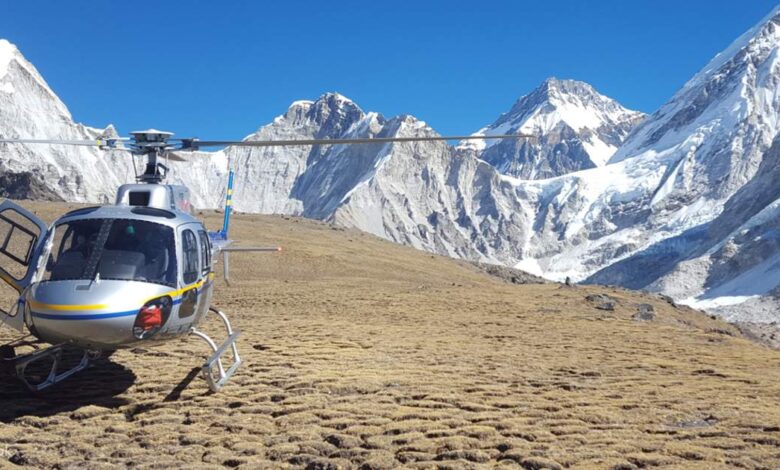Everest Base Camp Trek with Helicopter Return

The Everest Base Camp (EBC) trek with Helicopter return is a unique experience of trekking and helicopter flight. The trip is filled with adventures from trekking and a relieving dramatic view of the Everest region from the comfort of a helicopter seat.
During the journey, you can reach up to 5550 meters (18,209 ft) at Kala Patthar on the 10th day of the trekking with a EBC Helicopter Return expedition. Additionally, you can enjoy the panoramic view of peaks that are over 8000 meters tall, as well as their surroundings.
Further, a trek along the Dudh Koshi and Imja River through the vibrant rhododendron forest is an experience of a lifetime. Furthermore, if you are lucky enough, you can see rare mountain species like the Himalayan Tahr and snow leopard. Not to forget, there is an exhilarating flight to Lukla.
Highlights of EBC Trek with Helicopter Return
- Scenic flight from Kathmandu to Lukla.
- A chance to see a close view of Mount Everest.
- Explore the traditional Sherpa villages on the route.
- Trek through the lush forest of Sagarmatha National Park.
- Stunning view of various mountains such as Ama Dablam, Lhotse, Cho Oyu, and Pumori.
Trek Facts
- Duration: 10 days (9 trek days)
- Maximum Elevation: 5550 meters (Kala Patthar)
- Best Season: Spring (March to May) and autumn (September to December)
- Accommodation: Lodges/Teahouses
Trip Itinerary
Day 01: Arrival at TIA in Kathmandu (1400 m)
Day 02: Flight from Kathmandu to Lukla (2840 m) and trek to Phakding (2618 m)
Day 03: Trek from Phakding to Namche Bazaar (3440 m)
Day 04: Acclimatization Day at Namche Bazaar (3440 m)
Day 05: Trek from Namche to Tengboche (3860 m)
Day 06: Trek to Dingboche (4410 m)
Day 07: Acclimatization Day at Dingboche (4410 m)
Day 08: Trek from Dingboche to Lobuche (4940 m)
Day 09: Trek From Lobuche to Gorakshep (5164 m) and Hike to EBC (5364 m)
Day 10: Hike from Gorakshep to Kala Patthar (5550 m) and Flight from Gorakshep to Kathmandu
Challenges during the EBC Trek with Helicopter Return
One of the most common challenges during the journey is altitude sickness. While you are on a trek, as you trek to higher elevations over 2500 meters, you might fall victim to altitude sickness. So, remember to acclimatize to the increasing elevation and hydrate yourselves. Be aware of early symptoms of sickness to avoid any further hazards.
Likewise, hypothermia, hypoxia, insomnia, loss of appetite, diarrhea, etc., are some other challenges that you might encounter during the trek. Likewise, for some, the helicopter and flight to Lukla can be frightening. However, the flight operators are experienced pilots, so you need not worry about it.
Cultural Significance of the Trek
One of the most exciting parts of the Everest Base Camp trek, with a return by helicopter, is a chance to interact with the Sherpa people and their culture. They are known for their mountaineering expertise and friendly and hospitable nature. The trek passes through various Sherpa villages like Namche Bazaar, Tengboche, and Dingboche.
You can also visit the aborigine Sherpa people if you are willing to trek to Khumjung and Kunde village during acclimatization day at Namche Bazaar. Additionally, you can enjoy the ‘Saturday market’ every Saturday at Namche, where people from different places come and sell their homemade products and artifacts.
Why Helicopter Return?
A helicopter return from Gorakshep after a strenuous trek to Base Camp has various benefits. The major benefit of the helicopter return is an escape from the gruelling trek back after reaching the base camp. Our bodies will be already tired and might not have enough energy to walk back, so returning to a comfortable helicopter flight could be an ideal option.
Likewise, if you are a little short on time, a helicopter return could reduce trekking days by 2 to 4 days. Moreover, the helicopter ride offers a unique aerial view, unlike the view during the trek. You can see the eagle-eye view of the trekking route that you took while reaching the base camp from your seat. You will be amused to see an awe-inspiring view of the Everest region and Himalayan peaks, deep valleys, and glaciers.
Lastly, a helicopter could also be a precautionary move to avoid altitude sickness or in case of emergency. It ensures a safe and quick evacuation in such cases.
To be precise, a helicopter return after the Everest Base Camp trek is going to be an unforgettable experience.



